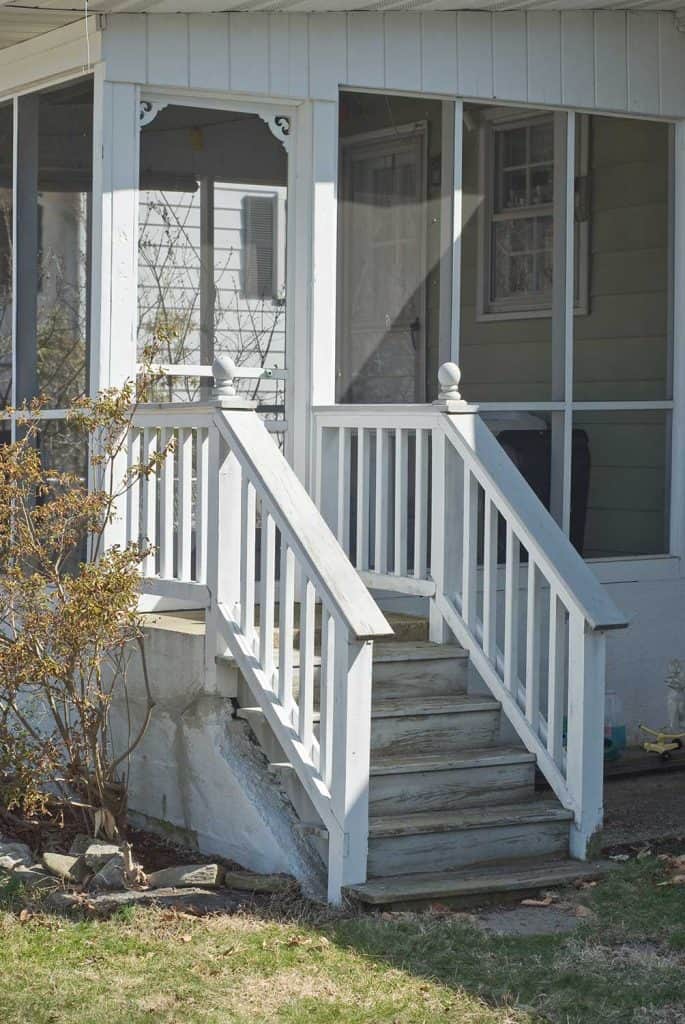Screen doors are prone to all sorts of damage from outside elements and wear and tear resulting from daily usage. Metal-based screen doors can rust over time, and wooden screen doors can fade or chip over time--both can look unsightly when they do. A painted screen door can make your door look completely brand-new, adding to your home's curb appeal. But how exactly do you paint a screen door? And what type of paint do you use? We've gathered the answers to these questions for you.
Here are the basic steps to paint a wooden or metal screen door:
- Lay down a drop cloth
- Clean the screen door
- Make door repairs as needed
- Apply painter's tape to the door
- Sand the screen door (wooden doors only)
- Prime the screen door
- Paint the screen door
- Apply additional coats as needed
- Remove the painter's tape
- Allow the door to dry
As with any paint project, planning and preparation are key. It's important to first determine all of the materials that you'll need for your project, as well as get an overall estimate of how long it will take to complete. Once you have these details, you're off to the races. Continue reading to learn more about the steps involved in painting a screen door.
![A front entrance of a quaint house with screen door, How To Paint A Screen Door [A Complete Guide]](https://homedecorbliss.com/wp-content/uploads/2021/01/How-To-Paint-A-Screen-Door-683x1024.png)
Steps To Paint A Screen Door

Things you'll need for this project:
- Gloves
- Painter's tape
- Dust mask
- All-purpose cleaner
- 2-gallon bucket
- 220-grit sandpaper
- Paintbrush or foam brush
- Oil-based primer
- Sponge
- Oil-based paint
1. Lay down a drop cloth
Whether you are removing your door to paint it or painting it while it's still attached to the hinges, you'll need to lay down a drop cloth. If you are painting your door on the ground, be sure that the drop cloth has at least one foot of space on each side of the door.
We may include affiliate links and curated AI content to highlight top design styles.
Click here to see these drop cloths on Amazon.
2. Clean the screen door
It's important to clean your screen door before painting it. You can use an all-purpose cleaner or mild dish soap to clean the screen door or you can create your own homemade solution (try vinegar and water in a 1:1 ratio). First, prop your screen door open.
Next, fill your 2-gallon bucket with warm water. Then, pour 1-2 cups of cleaning solution into the bucket. You can use a rag or sponge to apply the cleaning solution to the door. Be sure to wring it out to avoid creating a puddle around your painting area. If your door is especially dirty, you may want to use a sponge to help pick up any hard-to-remove grime.
3. Make door repairs as needed
Screen doors are known for taking a lot of abuse daily. Wooden doors are especially susceptible to dents and puncture holes. Do a quick inspection of your door and take note of any areas where you may need to do a small repair.
If it needs touch-ups, grab your spackle and putty knife and fill in any dents or holes. You can also use an epoxy wood filler if the door has any holes that are more than an eighth of an inch deep.
Click here to see this wood filler on Amazon.
If you have a metal-based door, you may want to purchase a filler that's specially formulated for metal surfaces. Apply the filler and then smooth it out with your putty knife. Next, level it off so that it will not leave a large hump when you start to sand the door.
Click here to see this metal filler on Amazon.
4. Apply painter's tape to the door
If you don't plan to paint the actual screen on your screen door, you'll need to cover it with a drop cloth or other material and apply painter's tape to the edges to secure it. You can also use old newspapers, sheets, or even scrap cardboard.
Pay special attention to the area near the edge of the screen door so that the painter's tape will not cover the intended paint area. Make sure that you cover any hardware on the door including decorative ornaments, doorknobs, or handles.
5. Sand the screen door (wooden doors only)
Before sanding the screen door, be sure to dawn a dust mask or ventilator to prevent inhaling any debris. Next, grab a piece of 150 to 220-grit sandpaper (or your orbital sander) and start at the top of the door, sanding it from left to right. Make sure to sand away any uneven surfaces, ridges, or bumps on the door.
If you find any areas of old peeling paint, you may want to scrape them off with your putty knife first and then sand them. Once you have sanded one side of the door, take your hand and go over the door to test its smoothness. You can also take a damp or dry cloth and wipe down the door to remove any extra debris. If the door is smooth enough, begin sanding the opposite side.
Click here to see this orbital sander on Amazon.
6. Prime the screen door
Whether your door is made of metal or wood, you'll need to prime it before applying your first coat of paint. Primer works as a bonding agent to ensure that the paint will adhere well to the surface of the door. You can use an oil-based primer if you have a wooden door or a metal-safe primer if the door is made of aluminum or steel. Start by pouring your primer into the paint tray.
To apply the primer, take a 1-inch paintbrush and dip it in the paint tray. Scrape off any excess primer on the side of the paint tray. Start at the top of the screen door and apply the primer using even vertical strokes. Once you've completed one side, start on the other side using the same technique. If you have removed the door, you'll need to let the first side dry first before painting the other side.
The primer can take anywhere from 1 to 3 hours to dry. It's best to check the drying time for your specific timer, which should be listed on the back of the paint can. The outside temperature can affect the drying time of the timer--warmer temperatures (72 degrees or higher) will help it to dry faster.
Click here to see this exterior primer on Amazon.
7. Paint the screen door
Once the primer has dried, pour the remaining primer from the paint tray back into the can and whip out a new paintbrush (or clean the one that you used for the primer). Pour your paint into the paint tray and dip a 1-inch or 2-inch paintbrush into it, scraping any excess of the side.
Only the bristles of the paintbrush should be covered with paint. Start at the top of the door on the side where you first applied the timer. Use the same painting technique to apply the paint to the door. Be sure not to apply too much paint on the first coat to avoid bubbling.
Apply the paint in one direction and continue until the entire surface of the door is covered. Once you have completed one side, start on the other side. Give the paint time to dry before applying the second coat. During this time, it's a good idea to look over your paint job to ensure that you haven't missed any areas.
Note: It's always a good idea to double-check the type of paint that you've purchased to ensure that it will work for the type of screen door that you have.
Click here to see this exterior paint on Amazon.
8. Apply additional coats as needed
After the first coat of paint has dried, go back to apply additional coats as needed. It's typically recommended that you apply at least one additional coat to help protect the door from dents, scratches, and outdoor weather elements. Make sure to let each coat dry before applying the next coat.
9. Remove the painter's tape
After the last coat of paint has almost dried, remove the painter's tape from the door, making sure to pull it off in a smooth steady motion. It's best to let the paint dry for about 30 minutes before removing the painter's tape.
Click here to see this painter's tape on Amazon.
10. Allow the door to dry
Keep the door propped open (or propped up if you are painting on the ground) for about 2-4 hours before closing it or reattaching it to the hinges. Before moving the door, make sure that the paint is completely dry to avoid smudging the new paint job.
What kind of paint do you use on a screen door?
Since your screen door will likely be exposed to wind, sun, rain, and other elements, it's best to pick a paint that is mold resistant and flexible, which is why exterior paint is ideal.
The most common types of exterior door paints are latex and acrylic resin-based paints. However, you can also use exterior oil-based paint on the door as well. Before choosing your paint, it's important to know the type of door that you have (i.e. wood, aluminum, steel, etc.), as this will also influence the best paint for your project.
Can you spray paint a screen door?
Yes, it's actually an easy way to paint the door. You can use canned spray paint, or buy traditional paint and apply it with a paint sprayer. If you use a paint sprayer for this task, be sure to thin the paint to avoid clogging the nozzle of the sprayer.
Should you paint or stain a screen door?
If your screen door is made of metal, you'll want to paint it, as stains are only made for wood surfaces. If your screen door is made of wood, it's a matter of personal preference.
A paint job will help the door stand up better to weather and daily wear and tear while a stain will allow the natural textures of the door to shine through. So it really depends on what you prefer from an aesthetic and durability standpoint.
Can you paint an aluminum screen door?
Yes, you can paint the door using the same technique as mentioned in the earlier section of this post. Aluminum screen doors can be painted using exterior paint designed for metal surfaces.
How do you paint around the screen?
To paint around the screen on your door, you simply need to apply a single roll of painter's tape directly to the edges of the screen. Make sure that the tape does not touch the edges of the door that you are painting.
Can you paint a screen?
Yes, you can paint a screen. The best way to do so is to use a paint sprayer or canned paint to minimize the chance that you'll clog the holes within the screen.
Click here to see this paint sprayer on Amazon.
Or, you can get creative and paint your own personal design on the screen. This adds some unique character to the door.
Wrapping Things Up
The most important takeaways to remember are to make sure that you use the correct paint for your door type and to let each coat of paint dry before applying the second coat--otherwise, you might ruin the final finish. We hope that this post has provided you with all the information that you need to get your screen door painted in a jiffy!
Before you go, be sure to check out some of our other posts:










